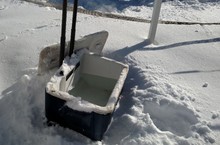Horse-keeping during the winter months brings unique challenges which can wreak havoc on your horse’s GI tract and increase his risk for digestive upset, but the right care and support will ensure keeping his digestive system healthy.

A cooler as a winter horse waterer
Horse-keeping during the winter brings unique challenges that can wreak havoc on your horse’s GI tract and increase risk of digestive upset, but the right care and support will ensure a healthy digestive system.
1. Limit changes in activity
Winter weather often leads to changes in your horse’s turnout and exercise routine. Research shows that increased number of hours spent in a stall has been associated with increased risk of colic. It also suggests that there is a higher risk of colic in horses that have a significant change in activity.
Keep your horse’s turnout and exercise schedule as consistent as possible, and try to make any changes gradually. When winter weather limits your horse’s turnout time, try hand-walking, lunging, or riding if possible.
2. Insure adequate water intake
Some horses drink less in the winter because of cold water, but proper hydration is essential to your horse’s well-being no matter season it is. Because a dehydrated horse may not have adequate water supplies to successfully pass feedstuffs through his digestive tract, he’s at risk for GI trouble, including impaction colic.
Make sure your horse has fresh water, ideally free from ice, available at all times. If your horse is a poor drinker, consider adding loose salt or a daily electrolyte to encourage normal drinking. In addition, a heated bucket or water bucket cover may be helpful if you notice your horse isn’t a fan of cold water.
Consider using insulated coolers as waterers in paddocks. At night, the coolers can be covered and on cold mornings, the ice is manageable with a rubber mallet and metal strainer. The cooler's role is to provide insulation from the freezing temperatures. Use a bungee cord to hold the covers open or cut the connector between the cooler and remove the lid during the day time so the horse cannot accidentally close the cooler lid and not have access to water.
3. Make careful feed changes
Changes in hay, including switching types or feeding a new cut, can increase your horse chances of developing colic by ten times. In addition, studies indicate that changes in the amount or type of grain can increase his risk up to five times.
Keep your horse’s diet as consistent as possible. If you must make a change to your horse’s hay or grain (either in type or amount), make the change gradually over 7-10 days. A digestive supplement that provides yeast, prebiotics, and enzymes may also help keep your horse’s hindgut happy as he makes feed transitions.
